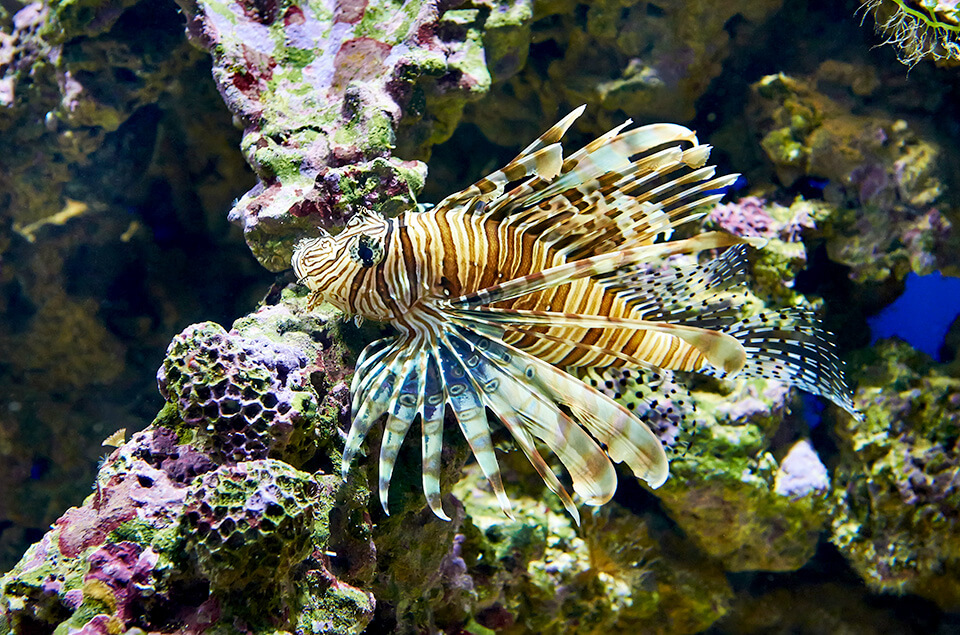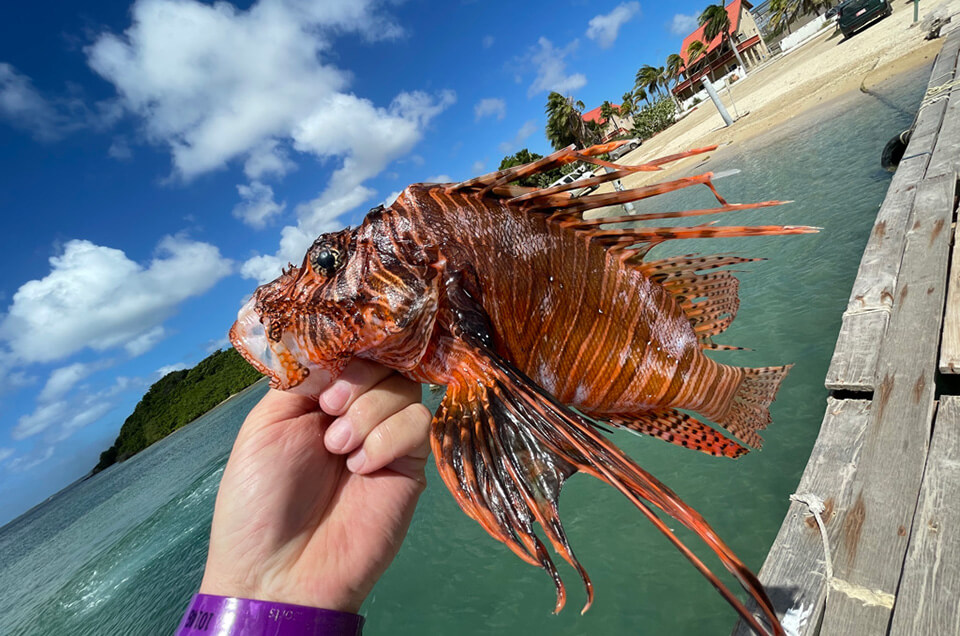Little Known Lionfish Facts in NJ & Globally

Facts about Lionfish
Lionfish are naturally gorgeous creatures, with vivid, scaly skin, stripes, and an anatomy mimicking the mane of a lion. While many home aquarium enthusiasts love to keep lionfish in their own collection, the species is actually considered invasive, as it has migrated from the Indo-Pacific region to the Atlantic Ocean. Today, lionfish are damaging natural ecosystems and repopulating at an unsustainable pace, mostly affecting the United States’ East Coast, the Gulf of Mexico, and the Caribbean.
Lionfishdivers.com has a simple mission – to ethically hunt and kill as many invasive lionfish as possible. Learn more about some surprising lionfish facts and the role Lionfishdivers.com plays in the Atlantic Ocean and abroad.
What Are Lionfish?
Lionfish are carnivorous and have venomous spines, which can cause painful stings to prey and humans. Now considered an invasive species in the Atlantic Ocean, lionfish primarily eat small fish, such as the young of snapper and grouper (two types of popular commercial fish), as well as crustaceans. There are numerous subspecies of lionfish, with the most common including:
- African lionfish (Pterois mombasae)
- Clearfin lionfish (Pterois radiata)
- Common lionfish (Pterois miles)
- Luna lionfish (Pterois lunulata)
- Red lionfish (Pterois volitans)
- Spotfin lionfish (Pterois antennata)
Learn more about lionfish and their effect on underwater environments from this video in English and Spanish. You can also get more information in our Lionfish Educational Flip Book Vol. 1 and Vol. 2.
Little Known Lionfish Facts
It’s well known that the lionfish invasion is causing problems in the Atlantic Ocean and Gulf of Mexico, but there is so much more to these marine creatures than meets the eye. Here are some little-known lionfish facts:
Native and Non-Native Ranges
Lionfish originate in the Indian Ocean and South Pacific region (also known as Indo-Pacific). From their native range, they extend to:
-
- French Polynesia
- Malaysia
- Micronesia
- New Zealand’s Kermadec Islands
- Southern Japan
- Southern Korea
- United Kingdom’s Pitcairn Islands
- Western Australia and Lord Howe Island
In 1985, the first lionfish sighting was reported in South Florida. Today, whether by natural migration or due to humans dumping aquarium lionfish, the species are now found along the U.S. East Coast, Bermuda, the Caribbean, and the Gulf of Mexico.
Nocturnal Hunting Habits
Lionfish are usually nocturnal hunters, but that doesn’t mean they aren’t seen during the day in the Atlantic. With voracious appetites, lionfish use their fins to hunt, with their venomous spines capable of delivering painful stings. They corner prey by stretching out their fan-like fins, slowly approaching and cornering their victims.
Lionfish eat over 50 species of fish, but their main prey includes crustaceans, such as crab and shrimp, as well as small fish. Unfortunately, a lot of the small fish they consume are the young of commercial fish, having a long-term effect on the country’s fresh seafood supply.
Predators
Scorpionfish, frogfish, and eels all hunt and eat lionfish. However, these predators are more common in their native range. In the non-native range, lionfish don’t have nearly as many natural predators. Because lionfish behavior is slow-moving, they depend on their brown, red, black, orange, white, and sometimes gray coloration and mane-like fins to scare off predators.
Reproduction
Female lionfish lay 2,000,000 eggs per year, up to as many as 15,000 at a time. The average clutch size is 8,000 eggs. The term clutch refers to how many eggs are laid in a nest at a single time.
Special Type of Scales
Lionfish have cycloid scales: the anterior part is overlapped by the posterior part of the next scale. This design gives lionfish better flexibility than fish with placoid, cosmoid, ctenoid, ganoid, and other types of fish scales.
If you’d like to gain more information about lionfish, numerous organizations are dedicated to helping increase knowledge of the invasive species.
Other Fun Facts about the Species
These lionfish facts are more commonly known:
Aquarium Value
Lionfish actually hold some economic importance in the pet industry in the United States and globally. Many fish tank and aquarium owners love to include lionfish due to their unique appearance and average lifespan of eight to 10 years.
Conservation Status
Lionfish are the farthest thing from a threatened or endangered species. However, coral reef pollution continues to increase, which can affect the lionfish’s food source in the long term. While populations are strong now, the future could hold a different story.
Edible
After removing the venomous spine safely, lionfish are entirely edible and can actually be quite delicious. The hunting equipment you’ll need to catch a lionfish include a spear, spear tips, containment device, first aid kits, and puncture-resistant gloves.
Hunting lionfish has become a significant sport for many people, as evidenced by the largest lionfish tournament in the world, The Emerald Coast Open (ECO). Lionfish cooking is also popular, with various ways to prepare the fish. Check out these cooking videos for inspiration.
Habitat
There are few places where lionfish won’t go in the great, open waters. Ranging between one to 300 feet under sea level, the most common lionfish habitats include:
-
- Artificial reefs, such as a shipwreck
- Coral
- Hard bottom surfaces
- Mangrove
- Rocky crevices
- Seagrass
- Other tropical reefs
Various Names for Lionfish
Depending on where you live or stories you have heard, lionfish could be called many different names, such as:
-
- Butterfly cod
- Devil firefish
- Firefish
- Ornate butterfly cod
- Peacock lionfish
- Red firefish
- Scorpion volitans
- Turkeyfish
- Zebrafish
Venomous Stings
Lionfish have venom glands that are located within each of their spines. The venom secreted is comprised of protein, acetylcholine (a neurotransmitter), and a neuromuscular toxin. If stung by a lionfish, humans can experience an extremely painful sting that can last for days. Complications of a lionfish sting can include sweating, respiratory distress, and paralysis. Those stung by a lionfish should seek medical attention immediately.
Learn More about Lionfish and Lionfishdivers.com’s Mission
Roger J. Muller, Jr. is an international lionfish hunter, who dedicates his free time outside of Muller Insurance to hunting lionfish. The goal of Lionfishdivers.com is to help restore natural balance and prevent further ecosystem degradation in the Atlantic Ocean and other affected areas. To learn more lionfish facts, contact Roger J. Muller, Jr., at Lionfishdivers.com today.





